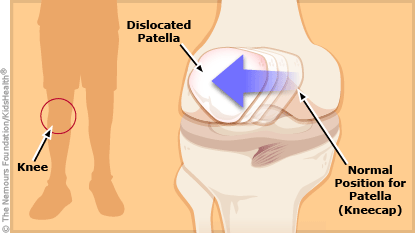Dislocated Kneecap (Dislocated Patella)
en español: Rótula dislocada
Medically reviewed by: Melanie L. Pitone, MD
What Is a Dislocated Kneecap?
A dislocated kneecap is when the bone in the front of the knee — called the kneecap or patella — slides out of place.
What Are the Signs & Symptoms of a Dislocated Kneecap?
Common symptoms of a dislocated kneecap or dislocated patella (peh-TELL-uh) include:
- feeling like the knee buckled or “gave out”
- sudden, severe pain and swelling
- a bump noticed on the outside of the knee. This is the kneecap that is out of place.
- the knee is held in a bent position
- bruising around the knee



